As part of the Make America Healthy Again (MAHA) agenda, U.S. Secretary of Agriculture Brooke Rollins and U.S. Health and Human Services Secretary Robert F. Kennedy Jr. visited Ferdinand T. Day Elementary School in Alexandria, Virginia, to see the impact of child nutrition programs in action.
Read MoreAre edamame creditable in the CACFP?
Read MoreWe are pleased to share the exciting news that James (JC) Miller has joined the United States Department of Agriculture (USDA) as the new Administrator for Food and Nutrition Services (FNS), effective March 24th. With a wealth of experience in leadership across healthcare, nonprofit, and government sectors, James is poised to bring a strong focus on improving the efficiency, transparency, and effectiveness of USDA’s nutrition programs.
Read MoreApril Virtual Events April 1, 2025 We’re only two weeks away from the National Child Nutrition Conference in Dallas, TX. No April Fool’s pranks here! Before we see you in Dallas though, be sure to catch our next webinar on “Supporting Autism in Early Childhood Settings”. After this we start diving into all things conference.…
Read MoreDoes tomato sauce credit by volume served in the CACFP?
Read MoreApril Virtual Events April 1, 2025 We’re only two weeks away from the National Child Nutrition Conference in Dallas, TX. No April Fool’s pranks here! Before we see you in Dallas though, be sure to catch our next webinar on “Supporting Autism in Early Childhood Settings”. After this we start diving into all things conference.…
Read MoreThis year, National CACFP Week was formally recognized at federal, state, and local levels. Read more to learn how your peers raised awareness of the CACFP!
Read MoreThe 2025 National Child Nutrition Conference (NCNC25) is set to be an inspiring and impactful event, bringing together professionals dedicated to child nutrition and community advocacy. This year’s General Session will feature an exceptional lineup of speakers, led by Texas Agriculture Commissioner Sid Miller, keynote speaker Mike Brown, Jr. and remarks from NCA leadership and USDA.
Read MoreInspired by NCNC25 Keynote Speaker Mike Brown, Jr.
The National Child Nutrition Conference is more than just a training opportunity, it’s a chance for our community to come together, connect and get inspired. This year, we are thrilled to announce our keynote speaker, Mike Brown, Jr., MS, CFRE, President and CEO of the YMCA of Metropolitan Fort Worth.
Read MoreCheck out these virtual events coming up this month at NCA!
Read MoreThe National CACFP Association proudly announces the upcoming 39th annual National Child Nutrition Conference (NCNC), set to take place both in-person at The Anatole Dallas and virtually online. The event will bring together over 2,100 passionate individuals from organizations across the country including child care centers, home providers, sponsoring organizations, school districts, afterschool programs, Head Start programs, Food Banks, tribal nations, and State Agencies.
Read MoreNCA understands that the end of flexibilities will cause challenges for many CACFP sponsors and providers and we commend your continued commitment to providing nutritious meals and snacks to the children or adults in your care. In preparation for the end of the additional reimbursement, we have collected the following resources to help you successfully provide meals even if your available budget decreases.
Read MoreThis memorandum provides best practices for establishing a single application process for experienced program operators providing year-round meal services to at-risk children in low-income areas. This memorandum applies to State administering agencies and local organizations operating both the Summer Food Service and Child and Adult Care Food Programs.
Read MoreThe Consolidated Appropriations Act, 2023 authorized a permanent, nationwide Summer Electronic Benefit Transfer (Summer EBT) Program beginning in 2024. The USDA released a memorandum providing information to assist States and territories in preparing to implement Summer EBT in 2024.
Read MoreIn April 2022 Federal agencies transitioned from use of the Data Universal Numbering System (DUNS) number to the Unique Entity Identifier (UEI). Child Nutrition Program Operators are required to have the UEI to receive payments from State agencies who administer the Child Nutrition programs on behalf of the Federal government. This memorandum provides answers to questions related to the transition.
Read MoreDuring the entire month of August, every congressional representative will be back in their home state. Don’t miss this opportunity to advocate for CACFP! Showcasing your program is one of the most impactful ways to advocate for the CACFP. Invite your elected officials to visit your site in August.
Read MoreThe Child and Adult Care Food Program has new creditable foods listed on the USDA Food Buying Guide! If you are new to the FBG, this interactive tool allows for easy display, search, and navigation of food yield information. In addition, users can compare yield information, create a favorite foods list, and access tools, such as the Recipe Analysis Workbook (RAW) and the Product Formulation Statement Workbook.
Read MoreThe Child and Adult Care Food Program community asked for more Spanish resources to be available on the National CACFP Sponsors Association website and we heard you! Available now in Spanish are more resources to help sponsors and providers with meal pattern requirements, best practices, and so much more!
Read MoreServing meals to young people year-round benefits children, families, and care providers. To do this, many providers transition from operating the USDA Child and Adult Care Food Program (CACFP) At-Risk Afterschool (ARAS) during the school year to the Summer Food Service Program (SFSP) while school is out. For an overview of the main differences between SFSP and CACFP ARAS, see the comparison chart below.
Read MoreNCA understands that the end of flexibilities will cause challenges for many CACFP sponsors and providers and we commend your continued commitment to providing nutritious meals and snacks to the children or adults in your care. In preparation for the end of the additional reimbursement, we have collected the following resources to help you successfully provide meals even if your available budget decreases.
Read MoreCDC created three new fact sheets for Early Care and Education (ECE) providers about Early Child Nutrition and Feeding. The fact sheets offer tips and best practices for supporting breastfeeding families, information about safe storage and handling of breastmilk, and strategies for introducing solid foods.
Read MoreAre edamame creditable in the CACFP?
Read MoreDoes tomato sauce credit by volume served in the CACFP?
Read MoreDoes tomato paste and tomato puree credit based on the volume served?
Read MoreIs there a milk transition period for infants and preschool age children?
Read MoreIs a medical statement needed for meal modifications due to disability reasons?
Read MoreAre there updated sugar limits for breakfast cereals in the CACFP?
Read MoreThe Child and Adult Care Food Program has new creditable foods listed on the USDA Food Buying Guide! If you are new to the FBG, this interactive tool allows for easy display, search, and navigation of food yield information. In addition, users can compare yield information, create a favorite foods list, and access tools, such as the Recipe Analysis Workbook (RAW) and the Product Formulation Statement Workbook.
Read MoreThe Child and Adult Care Food Program community asked for more Spanish resources to be available on the National CACFP Sponsors Association website and we heard you! Available now in Spanish are more resources to help sponsors and providers with meal pattern requirements, best practices, and so much more!
Read MoreServing meals to young people year-round benefits children, families, and care providers. To do this, many providers transition from operating the USDA Child and Adult Care Food Program (CACFP) At-Risk Afterschool (ARAS) during the school year to the Summer Food Service Program (SFSP) while school is out. For an overview of the main differences between SFSP and CACFP ARAS, see the comparison chart below.
Read MoreNCA understands that the end of flexibilities will cause challenges for many CACFP sponsors and providers and we commend your continued commitment to providing nutritious meals and snacks to the children or adults in your care. In preparation for the end of the additional reimbursement, we have collected the following resources to help you successfully provide meals even if your available budget decreases.
Read MoreCDC created three new fact sheets for Early Care and Education (ECE) providers about Early Child Nutrition and Feeding. The fact sheets offer tips and best practices for supporting breastfeeding families, information about safe storage and handling of breastmilk, and strategies for introducing solid foods.
Read MoreThe “Characteristics of Emergency Shelters Participating in the CACFP” study by USDA seeks to better understand the characteristics of CACFP emergency shelters, who they serve, how CACFP fits into their operations, and their challenges with CACFP. The study was conducted in 2023 and collected data from 242 emergency shelters that participate in CACFP in Fiscal Year 2023.
Read MoreA survey was administered in the spring of 2023 of licensed California family child care homes (FCCH) to assess the perceived impacts of the increased reimbursement during the Covid-19 pandemic on CACFP participation and anticipated challenges with reinstated tiered rates.
Read MoreThe USDA recently released a study on the “Characteristics of Adult Day Care Centers that Participate in the USDA’s Child and Adult Care Food Program” which seeks to better understand key characteristics of adult day care centers participating in CACFP.
Read MoreUSDA released a survey report focused on SFSP and SSO sponsors who operated the non-congregate meal service option in qualifying rural areas in summer 2023.
Read MoreAfterschool Snack Programs include the National School Lunch Program (NSLP) and the Child and Adult Care Food Program (CACFP). Through NSLP schools can serve one snack afterschool, however through the CACFP schools and sponsoring organizations are able to serve a snack in addition to a supper. This additional supper is an important opportunity to meet children’s nutritional needs after the school day is over. A report by the Food Research and Action Center (FRAC) found that afterschool supper participation increased from October 2022 to October 2023 by 6%.
Read MoreFRAC’s latest report, Hunger Doesn’t Take a Vacation: Summer Nutrition Status Report 2024, reveals a drop in the number of children receiving nutrition over the summer following the loss of pandemic-era waivers.
Read More


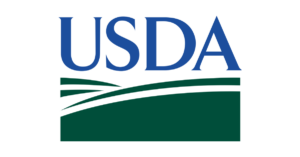



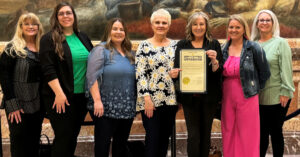
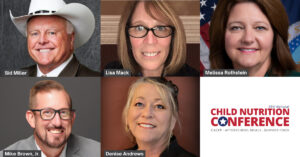










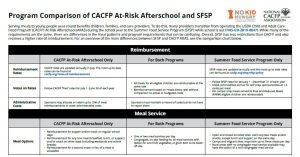
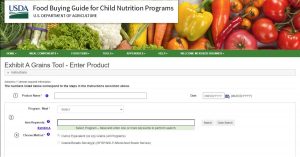









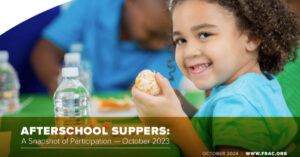
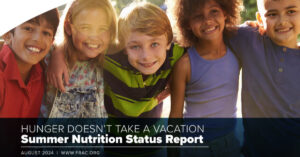


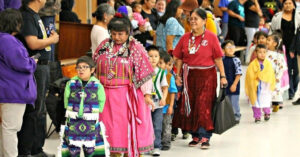
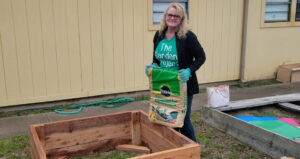
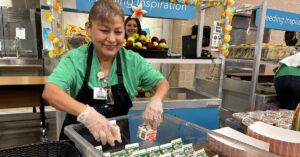
NCA Comments – Proposed Rule Revisions to Meal Patterns
In February 2023, USDA released the proposed rule Child Nutrition Programs: Revisions to Meal Patterns Consistent With the 2020 Dietary Guidelines for Americans. After meeting with NCA members and CACFP stakeholders, NCA provided a comment to USDA stating our position on the proposed changes, and additional comment on cost and administrative burden efforts, and created model comments for our members to personalize.
Read More